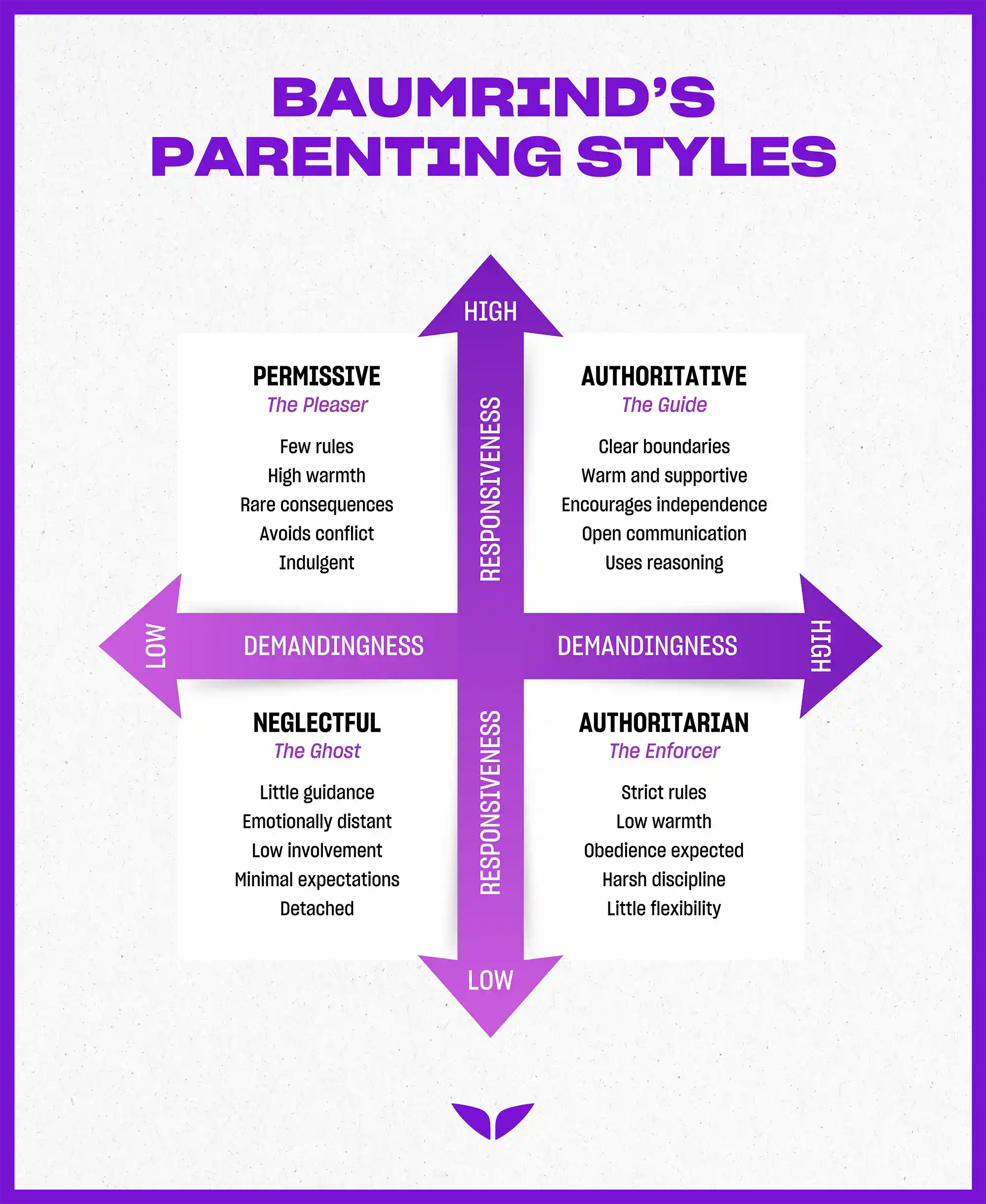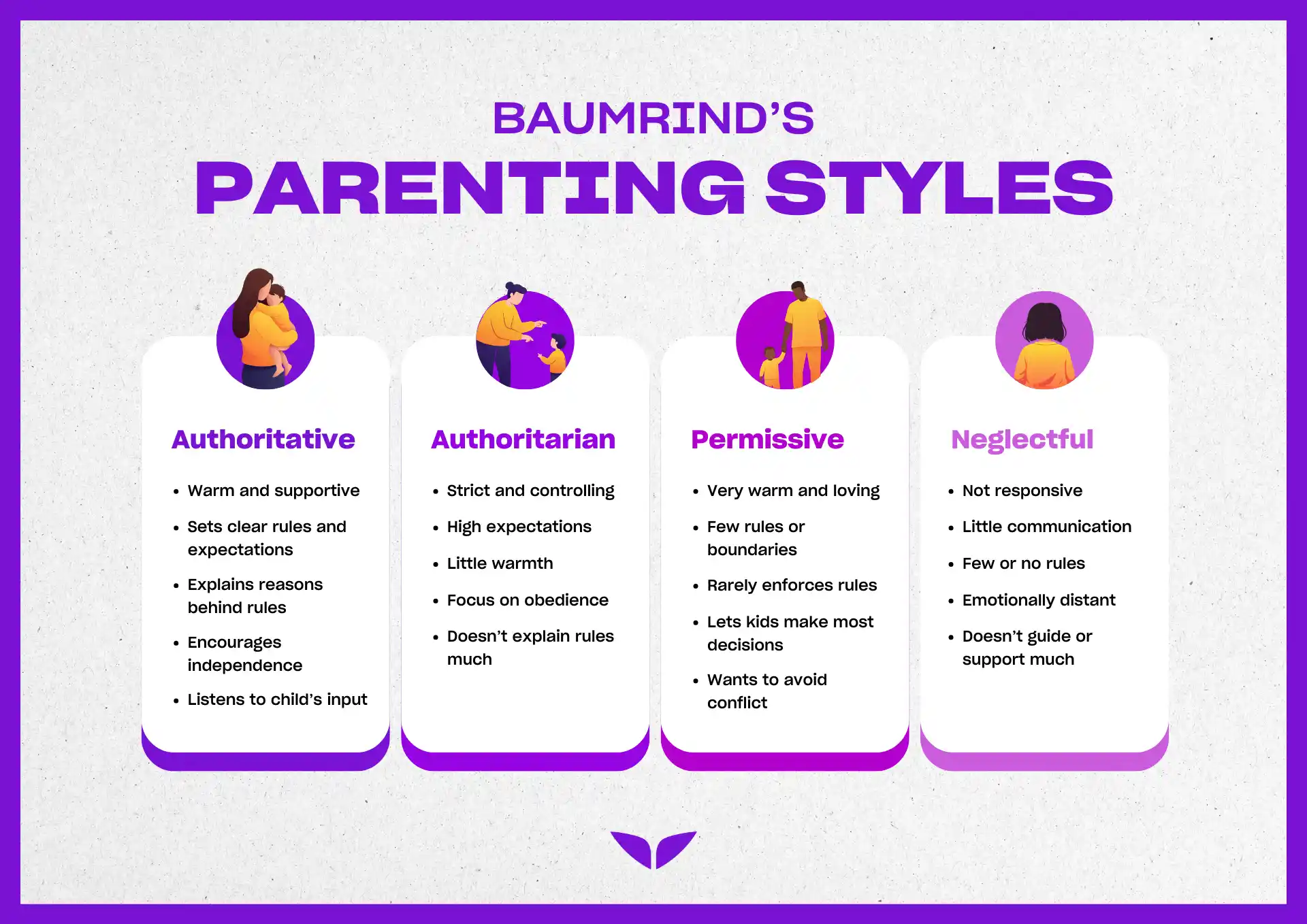Walk into any preschool or playground, and you’ll see a wide spectrum of parental vibes. Some hover over their kids, some bark at them, some cave into whims, and some, unfortunately, completely tune out.
If you look closer, though, you’ll notice the patterns line up with Baumrind’s parenting styles. And as a parent, do you know where you stand?
The thing is, knowing what these styles are can help you understand the difference between reacting on autopilot and raising your offspring with intention.
What are Baumrind’s parenting styles?
Baumrind’s parenting styles are the classic playbook psychologists use to explain how parents show up with their children. There are four of them:
- Authoritarian,
- Authoritative,
- Permissive, and
- Neglectful (or sometimes called “uninvolved”).
Diana Baumrind, a clinical and developmental psychologist, first sketched out this framework back in 1966 in her paper Effects of Authoritative Parental Control on Child Behavior. At the time, she spotted three styles in action: authoritarian, authoritative, and permissive.
It wasn’t until 1983 that researchers Eleanor Maccoby and John Martin expanded Baumrind’s framework in the Handbook of Child Psychology and introduced the fourth.
They might sound a little clinical, but as renowned parenting educator Shelly Lefkoe points out in her 2020 Mindvalley stage talk, “parenting is the greatest joy and the greatest challenge we will ever have in our lives.”
And so understanding Baumrind’s parenting styles can give you a clearer picture of your own family dynamic.
Who was Diana Baumrind, and when did she develop parenting styles?
Baumrind didn’t set out to write a parenting guide. But when she was a psychologist at UC Berkeley back in the 1960s, she observed parents and their preschoolers in action. And what she saw was hard to ignore: the parents had consistent ways of showing up.
Out of those observations came her 1966 paper, Effects of Authoritative Parental Control on Child Behavior, where she sketched out the three parenting styles.
A few years later, in 1971, she doubled down with Current Patterns of Parental Authority. In that study, she clarified the differences between the styles and showed how each one influenced children’s social skills, confidence, and overall adjustment.
Nowadays, you’ve likely heard of all sorts of labels—gentle, lawnmower, helicopter, and free-range, as well as FAFO parenting. All stem from Baumrind’s parenting styles characteristics.
That’s how influential her work is. The way she connected rules and warmth to a child’s confidence and emotional health is the reason experts still talk about her work decades later.
Baumrind parenting styles chart & characteristics
To make sense of Baumrind’s parenting styles, picture a simple grid.
On one axis, you’ve got responsiveness: how tuned in you are to your child’s needs. On the other, demandingness: how much structure, control, or expectation you bring to the table. Where those two lines cross is where the four styles live.
- Authoritarian parenting: high demands, low responsiveness. Rules rule; emotions take the back seat.
- Authoritative parenting: high demands, high responsiveness. Boundaries and warmth share the same house key.
- Permissive parenting: low demands, high responsiveness. Big on love, light on limits.
- Neglectful parenting: low demands, low responsiveness. Not much structure, not much support.

That’s the snapshot. On paper, it all fits into neat boxes, for sure. But in real life, not so much.
To make it easier, here’s a quick look at each style: their key traits, how they show up day to day, and what research says are the upsides and downsides.
| Style | Characteristics | Examples | Pros | Cons |
| Authoritarian | Strict rules, low warmth, obedience-focused | “Because I said so,” harsh punishment | Orderly, kids may comply quickly | Low self-esteem, anxiety, poor social skills |
| Authoritative | Clear limits, high warmth, open communication | Explains rules, encourages independence | High self-esteem, resilience, good social skills | Requires consistency and emotional energy |
| Permissive | Few rules, indulgent, high warmth | Letting the child set bedtime, avoids “no” | Strong bond, kids feel loved | Poor self-control, entitlement, difficulty with limits |
| Neglectful | Low warmth, low demands, disengaged | Absent at school events, little supervision | Kids may develop independence early | Attachment issues, poor academics, emotional struggles |
Shelly points out that “there is no such thing as a perfect parent.” The chart and table don’t judge you; they just help you see where you lean.
The four Baumrind parenting styles, explained
There are clear differences between authoritarian vs. authoritative, as well as how those compare to permissive or neglectful ones.
So what do Baumrind’s parenting styles actually look like when the rubber meets the road? Each one has its own vibe, its own set of rules (or lack of them), and its own impact on kids.
Let’s walk through them, one by one.
Authoritarian
The very word “authoritarian” comes from authority. It’s a “my way or the highway” approach, where strict rules, rigid schedules, and very little wiggle room for negotiation live. And when it comes to warmth and emotional attunement, you best believe it’ll take a backseat.
You’ll recognize it in examples like these:
- “Because I said so” as the end of any argument.
- Punishments are handed out quickly, without much explanation.
- Expecting obedience without room for dialogue.
“We mistakenly believe that this is the way we were meant to be good parents,” Dr. Shefali Tsabary says in her Conscious Parenting Mastery program on Mindvalley.
Andrea Markusich, one of her students from Canada, admitted the same on Mindvalley Stories. “I yelled a lot and didn’t know how to control my emotions with my kids,” she shares. “I tried harder to look like a good parent than to be one.”
Sure, it works in the moment. But the problem is, children can grow up more anxious, less confident, and lower in self-esteem. Decision-making takes a hit, too, because choices were always made for them. Over time, trust erodes, communication shuts down, and fear replaces resilience.
So how do you know if you’re showing up for your own children in this way? Ask yourself this:
- Am I the kind of parent who says “because I said so” and leaves it at that?
- Is my go-to move to lay down the law instead of teaching the lesson?
- Do I care more about getting a yes than getting a hug?
While it may be true that adopting this parenting style might keep things under control in the moment, it can cost the connection your children need to thrive.
Authoritative
“Authoritative” also comes from the root word “authority.” While authoritarian = “strict obedience to authority,” authoritative = “respected and trusted authority.”
Out of Baumrind’s four parenting styles, this one stands out as the sweet spot. It blends high expectations with high warmth. Parents set clear boundaries, and they enforce them with empathy, support, and open conversation.
In practice, that looks like:
- Explaining the “why” behind rules.
- Holding firm while listening to feelings.
- Encouraging independence with guardrails.
As Shelly points out, “Your number one job is to parent in a way that has your child conclude positive beliefs about themselves and life.” And this parenting does just that.
Marmee March from Little Women and Danny Tanner from Full House modeled this style. Sure, they’re fictional, but they show how to raise confident children who respect rules and still feel safe to speak their minds.
The fact of the matter is, when your children grow up with authoritatives, they’re more likely to have higher self-esteem, stronger social skills, better emotional regulation, and solid academic performance.
Still, even this approach can misfire, especially if you’re inconsistent. When rules shift too often or warmth slips into over-involvement, the balance tips and the benefits fade.
So check in with yourself:
- Do I explain rules or just demand obedience?
- Do I keep limits firm yet flexible?
- When I discipline, do I lead with support?
As Baumrind highlights in her paper, this style is about leading with both backbone and heart. Do that, and you’re not just raising a well-behaved, confident little human who knows they’re loved.
Permissive
This way of parenting is also about warmth, nurturing, and affection. However, the difference between authoritarian vs. permissive is that the latter has very few boundaries, rules, and discipline.
Permissive parents usually mean well. Some want to avoid the harsh discipline they grew up with, others blur the line between parent and friend, and many are simply too drained to enforce rules.
In everyday life, it often looks like:
- Saying “yes” to avoid conflict.
- Letting kids set their own bedtime, meals, or routines.
- Acting more like a friend than a parent.
If you scroll through social media, the same pattern pops up with trendier labels, like helicopter, snowplow, and lawnmower parents.
But what’s in a name? They all still have Mean Girls’ Regina George’s mom and Modern Family’s Phil Dunphy written all over them.
As those shows illustrate, the children often struggle with self-control, boundaries, and authority outside the home. They may be more impulsive and less persistent when challenges arise.
While it’s easy to laugh at those TV parents, it’s harder to notice how much of that shows up in your own home. Short of asking yourself if you’re channeling Mrs. George (“I’m not like a regular mom, I’m a cool mom!”), you can reflect on questions like these:
- Am I avoiding discipline just to keep the peace?
- When my child pushes back, do I cave?
- In the moment, do I care more about being liked than setting limits?
As Dr. Shefali points out, children cannot handle unlimited freedom. And being permissive is a way to avoid being the parent your children need you to be.
Neglectful (uninvolved)
We all know the story of Cinderella. Lady Tremaine’s stepparenting methods are textbook neglectful.
She provided food, yes. Shelter, yes. But she was also completely emotionally absent from her stepdaughter’s well-being.
It comes as no surprise that this is the most damaging of Baumrind’s parenting styles. And it’s not because of harshness, but because of things like:
- Being physically present but emotionally checked out.
- Rarely knowing what your child is doing or who they’re with.
- Offering little guidance, rules, or support.
A student of Mindvalley’s Conscious Parenting Mastery program, Rizaldy Valenzuela from the U.S., used to pull something of a Lady Tremaine. He shares, “Each time I see my children are misbehaving, I always put them on time-out.”
Dr. Shefali explains that “our children pay a heavy price when we lack consciousness.” Research also shows that children raised in this kind of environment are at higher risk for attachment issues, poor academic performance, and struggles with self-regulation. Long-term, it can harm emotional health and relationships.
But how do parents get this way? Often it’s not intentional. Stress, burnout, or unresolved struggles can leave them feeling overwhelmed or too distracted to show up for their children.
So how do you know if this pattern is creeping into your own parenting? Start by asking yourself:
- Am I often too drained to truly engage?
- Are important details in my child’s daily life slipping past me?
- When I feel overwhelmed, do I pull away instead of leaning in?
“Your self-awareness is the only path toward a greater consciousness,” says Dr. Shefali. The moment you see the pattern, you’ve already begun to break it.

Find your parenting style
The reality is, most parents aren’t just one style. You might be authoritative at homework time, permissive at bedtime, and authoritarian when you’re stressed.
Your number one job is to parent in a way that has your child conclude positive beliefs about themselves and life.
— Shelly Lefkoe, parenting educator and co-founder and CEO of the Lefkoe Institute
So instead of aiming for perfection, start by getting honest about how you show up.
Your parenting style: Which one do you lean toward?
Curious where you land on Baumrind’s parenting map? Here’s a quick way to uncover your dominant style.
Instructions:
- Answer each question on a scale of 1–5:
- 1 = Never
- 2 = Rarely
- 3 = Sometimes
- 4 = Often
- 5 = Always
- Add up your total score.
Questions:
- How often do you set clear rules for your child and explain the reasons behind them?
- When your child disagrees, how often do you encourage them to share their opinions?
- How frequently do you comfort and support your child when they are upset?
- Do you expect your child to follow rules without questioning them?
- How much freedom do you give your child to make their own choices?
- How often do you stay actively involved in your child’s daily life?
- Do you leave your child to manage things on their own?
- How often do you expect quick compliance without explaining your decisions?
- When setting high standards, how often do you also guide your child toward achieving them?
- How much attention do you give to your child’s emotions?
Scoring:
- 10–17 = Neglectful
- 18–25 = Permissive
- 26–35 = Authoritarian
- 36–50 = Authoritative
Shifting into conscious parenting in 5 steps
No matter where you land on the quiz, the point isn’t to box yourself but to notice the patterns that show up most often. It’s like the question Shelly asks in her stage talk:
“What if we could shift the paradigm of parenting from ‘I am the boss of my child’ to ‘I am my child’s guardian angel’? How would you speak to them, and what would you do differently?”
That shift is where conscious parenting begins.
“Many people think that conscious parenting is about never saying no to our kids,” Dr. Shefali explains. “It’s not about that. It’s really about attuning with the child. You know, what does the child need?”
And here’s how you can make the shift:
1. Pause instead of project
One of the biggest blocks to real connection with your child is projection. That’s when you take your feelings, anxieties, or expectations and unknowingly drop them on your child.
“We might say, ‘Oh, my kid is so angry with me, and that’s why he’s not looking at me right now,’” says Dr. Shefali. The problem with that is, the more you project, the less space they have to figure out who they really are.
That’s where the conscious pause comes in. Instead of rushing in with your own storyline, stop for a beat. Ask yourself: Is this about my child’s reality, or my own ego talking?
That pause is powerful. It interrupts the habit of scripting their life, and when you practice this, you release your child from carrying your baggage. You stop casting them in your movie and let them be the stars of their own.
2. Practice empathic engagement
If there’s one thing that can quietly sabotage the parent-child bond, it’s hidden expectations.
“The moment we have an expectation of our children, especially if it’s extra or heavy, they smell it immediately,” Dr. Shefali explains. “They know we want something from them, and then they automatically begin to withdraw from us.”
She advises trading expectation for empathy. Instead of looking at your child through the lens of what you think they should be, practice meeting them where they are. That means:
- Name the expectation. Pause and ask: What am I hoping for that reality isn’t giving me?
- Reevaluate it. Is it even relevant, or is it a cultural script you’re unconsciously running?
- Make the choice. Either adjust the expectation or adjust the situation, but don’t stay stuck in the mismatch.
When you let go of the agenda in your head, you free up space in your heart. That’s when you can truly see your child in their natural state.
3. Lead with compassion
“We constantly judge our children,” Dr. Shefali points out. “We’re always labeling them. Their actions is good or bad or positive or negative, as if someone has appointed us the judge and the jury, the wardens, the prisoners, and the persecutors.”
The alternative to this? Compassion.
When you lead with it, you step out of superiority and into humility. You stop seeing yourself as the judge of right and wrong and instead meet your child with understanding.
This softens reactivity, expands tolerance, and builds the kind of trust that helps children feel safe enough to grow into who they are meant to be.
4. Feel your feelings
Raise your hand if you were ever taught to sit with your emotions. Not many of us, right? Most of us grew up being told to push them down, hide them, or get over them.
So it’s no surprise that when big feelings rise up, we react instead of respond—snapping, yelling, or shutting down.
But as Dr. Shefali highlights, feelings are not meant to be reacted to. “They’re not meant to be shown to the whole world or emoted upon,” she says. “They are meant to be done only one thing with: feel them.”
The next time your chest tightens or your jaw clenches, pause and name what’s happening: “This is anger. This is stress. Let me feel it, not fling it.”
When you do this, you break the cycle of reactivity. You show your child how to control their emotions, and you create a calmer, safer space for both of you.
5. Choose connection over control
If you’re like most parents, you’ve promised yourself countless times: Tomorrow, I’ll stay calm. Tomorrow, I’ll really connect. And yet, by breakfast, control sneaks back in.
Rhys, a student of Dr. Shefali’s from Australia, knows this struggle. “When I lose my temper and get angry, I feel the loss of dignity and self-respect after I have calmed down,” he shares.
Dr. Shefali herself has been through the same. She reflects, “I still remember after moments of conflict with my own kid, feeling so frustrated, knowing that darn it, I love my kid, why can’t I connect with my kid?”
That’s the thing with control. It’s often the wall that stands between the love you feel and the connection your child needs.
But the shift begins with you. Connection with your child can only grow from your connection to yourself.
If you’re fragmented, reactive, or closed off, your child senses the holes, not the wholeness. That’s why self-awareness and mindfulness are so central to conscious parenting.
So instead of trying to control, get curious. Ask more questions. Stay open-hearted and open-minded. Invite your child to share how they see things.
When you do so, the energy changes, and a genuine connection takes root.
Love deeper, connect stronger
Your child doesn’t need a perfect parent. They need a conscious one, someone who can meet them with presence, connection, and awareness.
That’s the heart of Dr. Shefali Tsabary’s Conscious Parenting Mastery on Mindvalley.
In this powerful program, endorsed by Oprah as “revolutionary,” Dr. Shefali will guide you through the inner work every parent needs:
- Healing your own childhood wounds,
- Breaking free from old patterns, and
- Creating the kind of deep, connected relationship your child craves.
The best part is, you don’t have to commit right away. You can start with a free lesson from the program and see for yourself how liberating this shift can feel.
Diana Venskyte Landborg, a Mindvalley member from Sweden, says the biggest shift was finally facing her own patterns. She shares:
I’ve learned to be more aware to what I am thinking and feeling. I also learned that I need to let go of control and over our children and my husband, so they can learn from their own mistakes. And not try to protect them from everything bad and fix everything.
Similarly, the more you nurture your own awareness, the more you’ll show up as the guide, anchor, and safe place your child needs most.
Welcome in.









